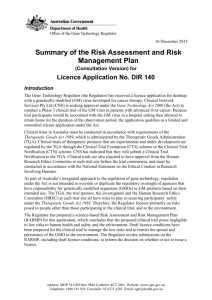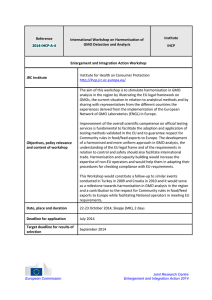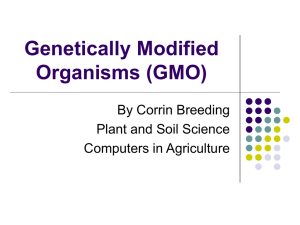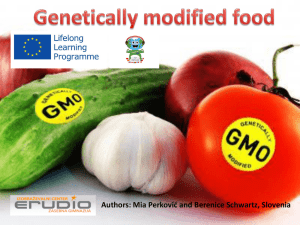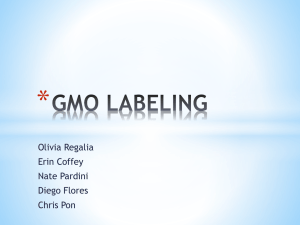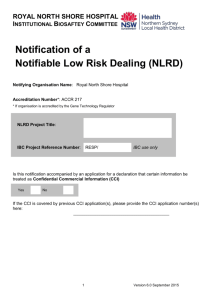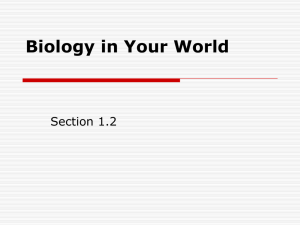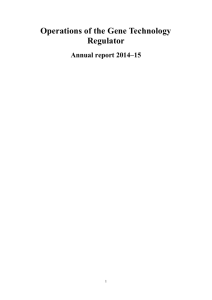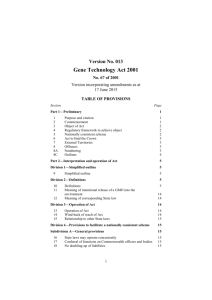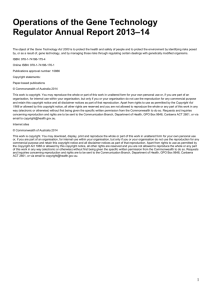Summary of Risk Assessment and Risk Management Plan
advertisement
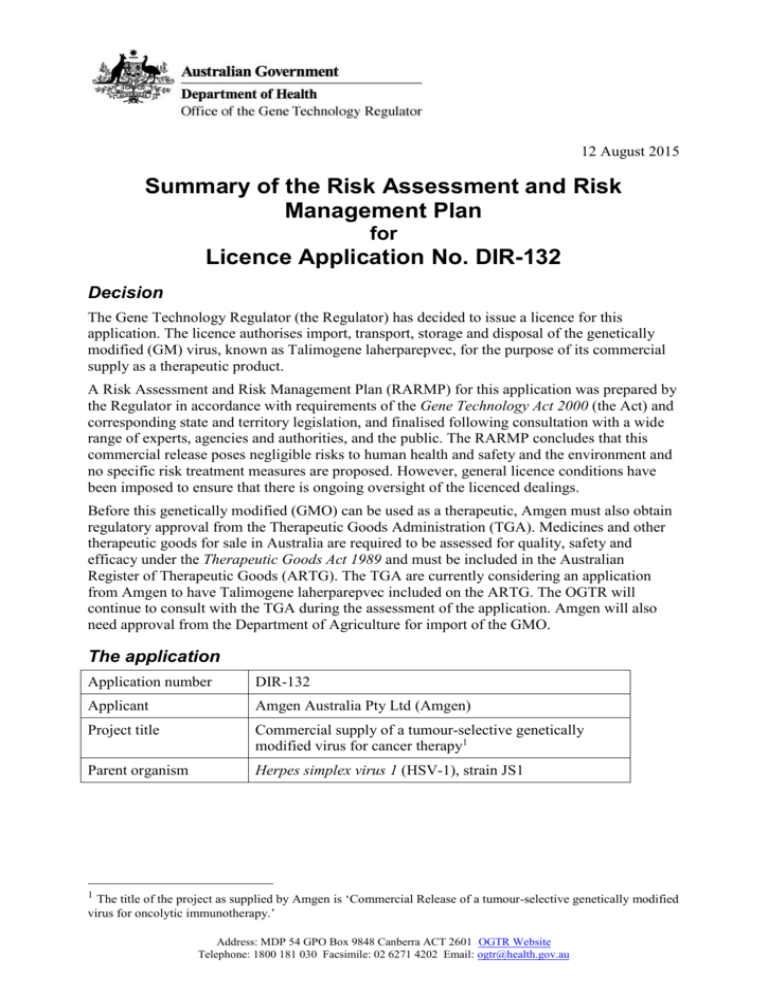
12 August 2015 Summary of the Risk Assessment and Risk Management Plan for Licence Application No. DIR-132 Decision The Gene Technology Regulator (the Regulator) has decided to issue a licence for this application. The licence authorises import, transport, storage and disposal of the genetically modified (GM) virus, known as Talimogene laherparepvec, for the purpose of its commercial supply as a therapeutic product. A Risk Assessment and Risk Management Plan (RARMP) for this application was prepared by the Regulator in accordance with requirements of the Gene Technology Act 2000 (the Act) and corresponding state and territory legislation, and finalised following consultation with a wide range of experts, agencies and authorities, and the public. The RARMP concludes that this commercial release poses negligible risks to human health and safety and the environment and no specific risk treatment measures are proposed. However, general licence conditions have been imposed to ensure that there is ongoing oversight of the licenced dealings. Before this genetically modified (GMO) can be used as a therapeutic, Amgen must also obtain regulatory approval from the Therapeutic Goods Administration (TGA). Medicines and other therapeutic goods for sale in Australia are required to be assessed for quality, safety and efficacy under the Therapeutic Goods Act 1989 and must be included in the Australian Register of Therapeutic Goods (ARTG). The TGA are currently considering an application from Amgen to have Talimogene laherparepvec included on the ARTG. The OGTR will continue to consult with the TGA during the assessment of the application. Amgen will also need approval from the Department of Agriculture for import of the GMO. The application Application number DIR-132 Applicant Amgen Australia Pty Ltd (Amgen) Project title Commercial supply of a tumour-selective genetically modified virus for cancer therapy1 Parent organism Herpes simplex virus 1 (HSV-1), strain JS1 1 The title of the project as supplied by Amgen is ‘Commercial Release of a tumour-selective genetically modified virus for oncolytic immunotherapy.’ Address: MDP 54 GPO Box 9848 Canberra ACT 2601 OGTR Website Telephone: 1800 181 030 Facsimile: 02 6271 4202 Email: ogtr@health.gov.au Office of the Gene Technology Regulator Introduced or modified genes and resulting modified traits Proposed locations Proposed release date Proposed activities deletion of ICP34.5 gene (human therapeutic attenuation) deletion of ICD47 gene (human therapeutic enhanced immune response) hGM-CSF gene encoding Granulocyte-Macrophage Colony-Stimulating Factor from humans (human therapeutic - enhanced immune response) At clinical facilities throughout Australia (subject to approval by the Therapeutic Goods Administration) Ongoing from date of approval Import, storage, transport and disposal of the GM virus for the purpose of administration by healthcare professionals as a prescription only medication for cancer therapy (administration is subject to Therapeutic Goods Administration approval) Amgen Australia Pty Ltd (Amgen) proposes the commercial supply of a genetically modified Herpes simplex virus 1 (HSV-1). Subject to approval by the TGA, the GMO would be used as a prescription only treatment for patients with skin cancer (metastatic melanoma) and other suitable solid tumours that are unable to be removed by surgery. The GMO will be administered to patients by injection directly into the tumour. The GMO would be manufactured overseas and imported into Australia for use in clinical facilities equipped to deal with scheduled drugs and infectious agents. Naturally occurring HSV-1 is a human pathogen that causes local skin lesions. It is highly contagious and widespread in the environment, with around 80% of the population estimated to be seropositive for the virus. Primary infection occurs most commonly in oral mucosal tissue (e.g. cold sore) and generally prior to the age of three. The primary infection is usually mild and self-limiting, although in a minority of cases infection may be severe, including disseminated disease and encephalitis. With the exception of neonates and immunecompromised people, HSV-1 infection is not systemic and is limited to the epithelial cells and sensory ganglia of the infection site. The GMO is an attenuated HSV-1 modified to selectively replicate in tumours (rapidly dividing cells) and enhance the immune response in treated cancer patients. To produce the GMO, HSV-1 was modified by removing specific viral genes involved in viral replication and viral antigen presentation, and by introduction of a gene encoding a human protein that stimulates certain types of immune cells. The GMO has not previously been used commercially, however it has been used in clinical trials on skin cancer and several advanced solid tumour types in multiple countries, including the United Kingdom, Canada, South Africa and the USA. In Australia, a phase III clinical trial of the GMO, under the name OncoVEXgm-csf, is being conducted under a GMO licence for dealings not involving intentional release (DNIR) of a GMO into the environment (licence DNIR-461). Australian patients started receiving treatment under DNIR-461 in December 2014. 2 Office of the Gene Technology Regulator Risk assessment The risk assessment concludes that risks from the proposed dealings, either in the short or long term, to the health and safety of people, or the environment, are negligible. No specific risk treatment measures are required to manage these negligible risks. The risk assessment process considers how the genetic modifications and proposed activities conducted with the GMOs might lead to harm to people or the environment. Risks are characterised in relation to both the seriousness and likelihood of harm, taking into account information in the application (including proposed controls), relevant previous approvals and current scientific/technical knowledge. Both the short and long term impact are considered. To avoid duplication of regulatory oversight, the Regulator does not assess risks to people receiving or administering the GMO as a therapeutic. However, import, transport and disposal are regulated under the Gene Technology Act 2000 (the Act), and the Regulator has assessed risks posed to people and to the environment associated with these activities. Credible pathways to potential harm that were considered included whether or not expression of the introduced genes and genetic modifications could: result in products that are toxic to people or other organisms; alter characteristics that may impact on the disease burden from the GM virus, or produce unintended changes in viral characteristics. The opportunity for gene transfer to other organisms, and its effects if it were to occur, was also considered. A substantive risk is only identified for further assessment when a risk scenario is considered to have some reasonable chance of causing harm. Pathways that do not lead to harm, or could not reasonably occur, do not advance in the risk assessment process. The risks to the health and safety of people, or the environment, from the proposed dealings with the GM virus have been assessed to be negligible. Hence, the Regulator considers that the dealings involved do not pose a significant risk to either people or the environment. The principal reasons for the conclusion of negligible risks are that the proposed controls applicable to therapeutic goods effectively minimise unintended exposure to the GMO; the parent virus only infects humans and the genetic modifications have not altered this specificity; the genetic modifications attenuate the GM virus such that its ability to replicate, to be transmitted or persist are significantly reduced; the introduced gene is of human origin and not expected to be toxic to people or the environment. Risk management plan Risk management is used to protect the health and safety of people and to protect the environment by controlling or mitigating risk. The risk management plan evaluates and treats identified risks, evaluates controls and limits proposed by the applicant, and considers general risk management measures. The risk management plan is given effect through licence conditions. As the level of risk is assessed as negligible, specific risk treatment is not required. However, the Regulator has imposed licence conditions under post-release review (PRR) to ensure that there is ongoing oversight of the release and to allow the collection of information to verify the findings of the RARMP. The licence also contains a number of general conditions relating to ongoing licence holder suitability, auditing and monitoring, and reporting requirements, which include an obligation to report any unintended effects. 3
